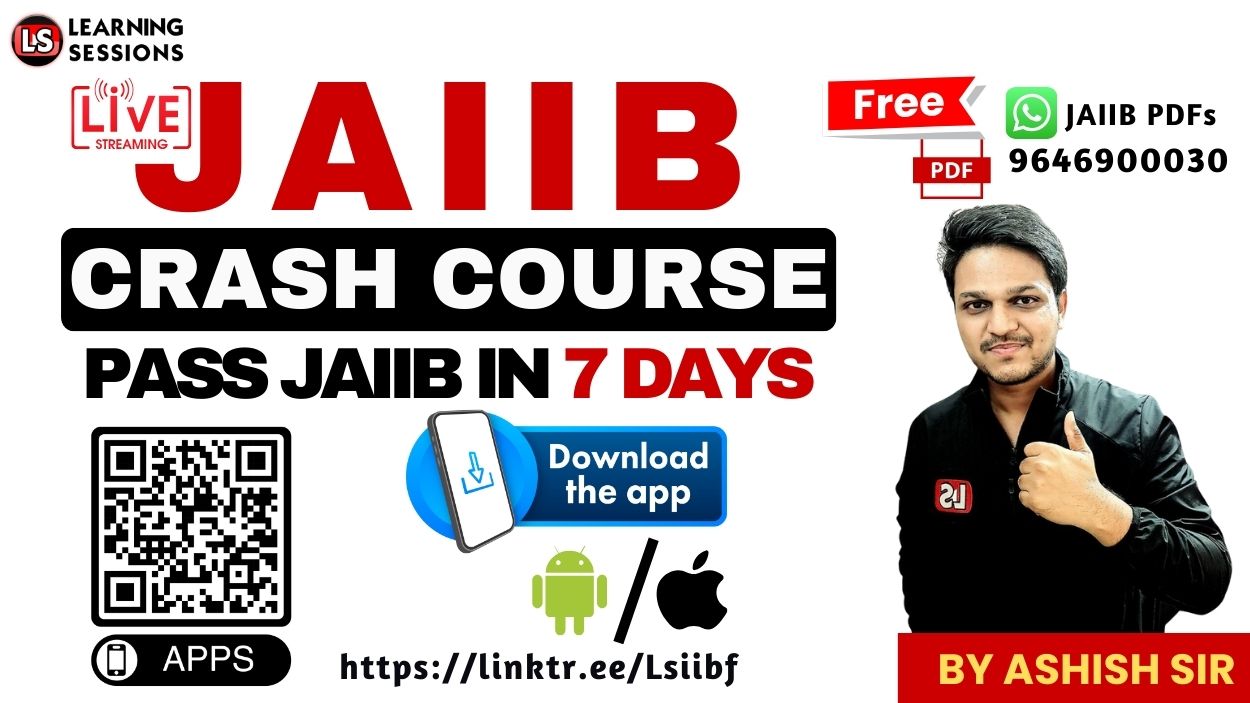Ever felt like BFM Module A is just too vast and unpredictable? You’re not alone.
Between complex regulations, Basel norms, Forex derivatives, and remittance schemes — the CAIIB BFM paper can feel overwhelming.
But here’s the good news — in this power-packed session, we’ve solved the most important previous year questions (PYQs) and exam-relevant MCQs from Module A, making your prep smarter, not harder.
📚 CAIIB Study Resources 📚
👉 Check Here
👉 Check Here
👉 Check Here
👉 Get Tests Here
👉 Check Here
👉 Click Here
👉 Click Here
This session is especially helpful if:
- You’re appearing for CAIIB for the first time and want quick clarity
- You’ve attempted CAIIB before but struggled with BFM
- You need revision + concept clarity in one go
Whether you’re a first-timer, a repeater, or just struggling to connect the dots — this video is crafted just for you.
So, grab your notes, hit play, and comment along as you learn.
We’d love to know how many questions you got right! 💬👇
🎥 Watch The Full Session:
👉 Before we dive in, watch this video for a complete breakdown:
00:45 – Q1: Liberalised Remittance Scheme (LRS)
Under the LRS, residents are allowed to remit up to USD 250,000 per financial year for permissible current or capital account transactions. Any amount beyond this cap requires explicit approval from RBI.
This question is a common feature in exams and understanding it helps you grasp FEMA fundamentals.
Correct Answer: USD 250,000 per financial year. RBI approval needed beyond that.
03:32 – Q2: Blockchain & Trade Finance Risk
Blockchain operates as a decentralized digital ledger where transactions are securely recorded. In trade finance, this means reducing dependency on intermediaries, cutting costs, and avoiding manipulation of data.
Correct Answer: Shared ledger prevents duplicated/conflicting records.
Imagine a world where every participant in a supply chain sees the same real-time truth — that’s blockchain at work!
06:47 – Q3: IFSC & IBU Regulations
India’s Gift City is home to the International Financial Services Centres (IFSCs), offering a global banking environment from Indian soil. The IBU units in IFSC are exempt from CRR and SLR — helping banks operate competitively in global markets.
Correct Answer: Option B – Only Statement 1 & 4 are correct
12:11 – Q4: Basel III LCR – Level 2B HQLA
Liquidity Coverage Ratio (LCR) is crucial for ensuring short-term liquidity. Under Basel III, high-quality liquid assets (HQLAs) are categorized into Level 1, 2A, and 2B based on their liquidity profile and haircut applied.
Correct Answer: Unsecured corporate bonds (≥ AA rating) with 50% haircut
18:33 – Q5: Role of EXIM Bank
EXIM Bank’s Lines of Credit help promote Indian exports by offering concessional long-term financing to foreign governments. This ensures Indian exporters have a competitive edge in international markets.
Correct Answer: To support development projects via long-tenure concessional financing
24:33 – Q6: FEMA – Import Payment Rules
This section clarified several myths about import payment regulations. The correct timeline for import remittance is 9 months, not 6. RBI approvals are mandatory beyond certain thresholds, and deferred payments don’t always qualify as trade credit.
Correct Answer: Option D – None of the above
30:12 – Q7: ECGC Comprehensive Policy
ECGC covers Indian exporters from two primary risks: Commercial Risk and Political Risk. Whether your buyer defaults or there’s a political upheaval in the buyer’s country — ECGC protects your business.
Correct Answer: Political & Commercial Risks
35:25 – Q8: FC-GPR Reporting Timeline
Foreign Currency-Gross Provisional Return (FC-GPR) is a mandatory filing with RBI. It must be filed within 30 days from the date of capital instrument allotment against FDI.
Correct Answer: Within 30 days of issuing capital instruments
[FREE PDF] CAIIB BFM Module A | Previous Year Questions & Most Important MCQs #2
37:41 – Q9: OTC Forex Derivatives – Operational Limits
Understanding derivative desk controls is essential for risk management. There are strict limits on position size, settlement risk, and counterparty exposure.
Correct Answer: Option A
42:13 – Q10: What Is Translation Exposure?
Translation Exposure arises when financial statements of foreign operations are converted into home currency. Even without cash flows, your balance sheet gets affected due to exchange rate changes.
Correct Answer: Revaluation risk of foreign currency assets/liabilities
📝 Conclusion:
This session was more than a quiz — it was a real-time concept builder. By addressing actual exam-level questions and explaining them, we’ve empowered you to tackle BFM like a pro!
- Got clarity on key FEMA & LRS provisions
- Understood how EXIM & ECGC function in global trade
- Grasped Basel norms and Forex exposures
🚀 Now it’s your turn to practice more questions, revise these areas, and ace your CAIIB BFM exam!
📌 Don’t forget to like, share & subscribe to stay updated on future sessions.
📥 Download PDF Notes
👉 Click here to download the full session notes as PDF
Also Like:







